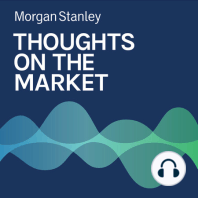4 min listen

U.S. Economy: What AI Means for People Doing Multiple Jobs
U.S. Economy: What AI Means for People Doing Multiple Jobs
ratings:
Length:
9 minutes
Released:
Sep 29, 2023
Format:
Podcast episode
Description
The number of U.S. workers with multiple income streams is increasing steadily, with earnings of $200 billion today poised to double by 2030. Generative AI could help these “multi-earners” hold down their many jobs.----- Transcript -----Ed Stanley: Welcome to Thoughts on the Market. I'm Ed Stanley, Morgan Stanley's Head of Thematic Research in Europe. Ellen Zentner: And I'm Ellen Zentner, Morgan Stanley's Chief U.S. Economist. Ed Stanley: And on this special episode of Thoughts on the Market, we'll discuss the impact of A.I. on the multi earning trend we've been observing over the last year. It's Friday, September 29th at 3 p.m. in London. Ellen Zentner: And 10 a.m. in New York. Ed Stanley: You'll remember that the pandemic created the conditions for many people to start pursuing multiple income streams, and post-COVID this need has shifted to an opportunity. And little over a year ago, we first wrote about the rise of multi earners, a large and growing class of workers who, we argued, whose marginal hour was better spent multi-earning than staying in a low paying traditional corporate role, for example. And not surprisingly, Gen Z, a group our economist team have studied in detail, is leading this paradigm shift, and that is clearly underway in our latest survey. Ellen, before we get into some of the current specifics on the fast moving multi-earner and A.I. Trends, can you set the stage for us by giving us a sense of where the US labor market is right now and how things have evolved since the great resignation that we heard so much about during COVID? Ellen Zentner: Sure Ed. Participation in the workforce dropped like a rock around COVID and government subsidies helped folks take time away, and particularly those that work in high risk areas of services where face to face contact is a necessary work requirement. Now, at the same time, the percentage of employees that shifted to some amount of work from home arrangements soared from about 15% to over 50%, and it's remained pretty sticky even as COVID has moved further into the rearview mirror. So while prime age labor force participation has fully recovered and continues to climb, the share of workers with some amount of work from home has remained elevated, as well as those that the Bureau of Labor Statistics here in the US has identified as holding multiple part time jobs. So it turns out it skews toward younger workers. In other words, Generation Z, as you noted, which is a growing share of the prime age workforce. And for many workers, COVID was a wake up call, a call to action, if you will, that multi-earning might better balance a sense of freedom and flexibility while still earning a living wage. Ed Stanley: To expand our lens even more in order to understand the economic backdrop of multi-earning, can you give us a quick overview of the rise of the so-called worker economy over the last two decades? Ellen Zentner: So here's a brief history lesson. Wage growth, when adjusted for inflation, has been falling for decades in the U.S. and is a reflection of factors such as waning presence of unions, the rise of mega companies and the like that reduced worker bargaining power over time. Wage growth should have kept up with gains in productivity, and it just didn't. And as a result, the labor share of corporate profits has been falling. COVID created the labor scarcity needed to reverse that secular decline in labor income by raising bargaining power. In a sense, it galvanized the demand for higher wages that we think is durable. Now Ed, as you mentioned, you first started publishing on the Multi-Earner Trend a year ago, and this trend has been developing by leaps and bounds, it seems, especially when you overlay the fast and furious development of generative A.I. So can you tell us what you're observing and how your thesis is evolving? Ed Stanley: Yeah. So there are three ways that we keep track of to triangulate how this thesis is evolving. The first is official data, and y
Released:
Sep 29, 2023
Format:
Podcast episode
Titles in the series (100)
Andrew Sheets: Fed to the Rescue? Maybe Not. by Thoughts on the Market